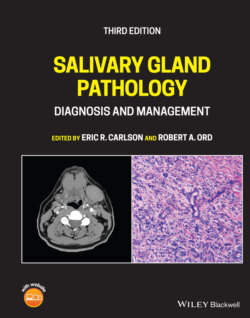Читать книгу Salivary Gland Pathology - Группа авторов - Страница 21
Parotid Gland EMBRYOLOGY
ОглавлениеThe parotid glands develop as a thickening of the epithelium in the cheek of the oral cavity in the 15 mm Crown Rump length embryo (sixth week of intrauterine life) (Zhang et al. 2010; Berta et al. 2013; Chadi et al. 2017). This thickening extends backward toward the ear in a plane superficial to the developing facial nerve. The deep aspect of the developing parotid gland produces bud‐like projections between the branches of the facial nerve in the third month of intrauterine life. These projections then merge to form the deep lobe of the parotid gland. By the sixth month of intrauterine life, the gland is completely canalized. Although not embryologically a bilobed structure, the parotid comes to form a larger (80%) superficial lobe and a smaller (20%) deep lobe joined by an isthmus between the two major divisions of the facial nerve. The branches of the nerve lie between these lobes invested in loose connective tissue. This observation is vital in the understanding of the anatomy of the facial nerve and surgery in this region (Berkovitz et al. 2003).
